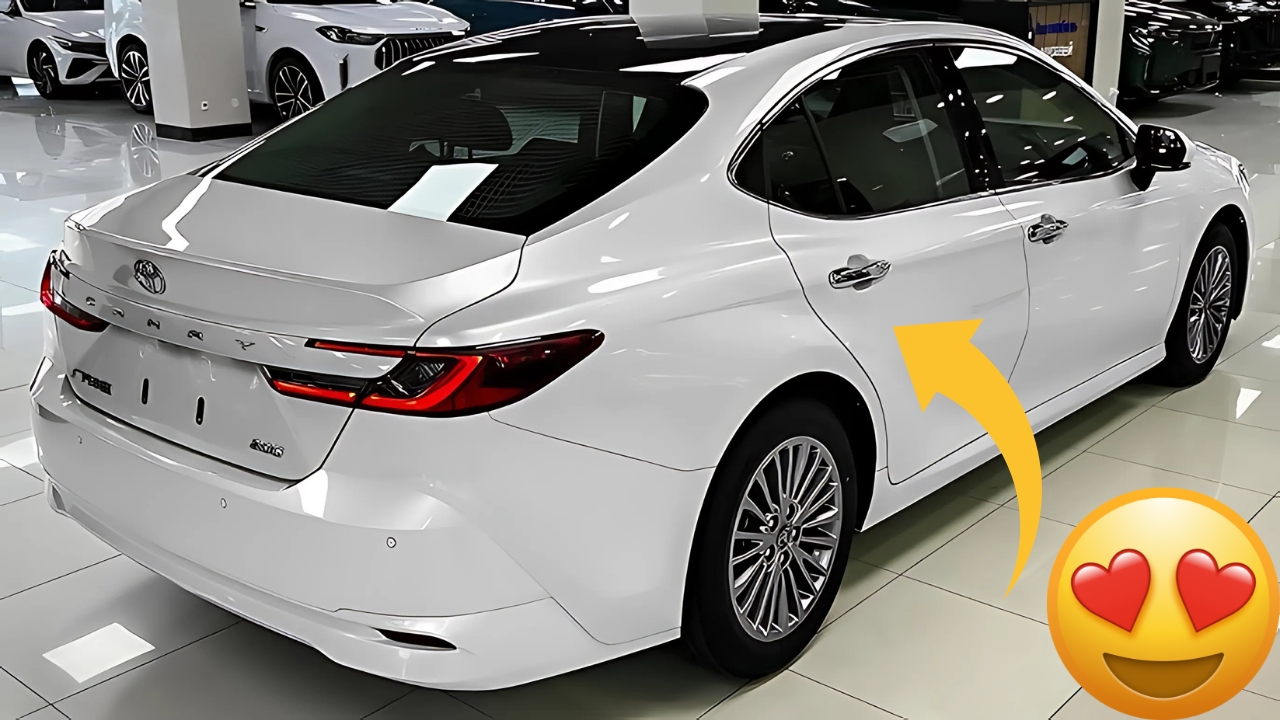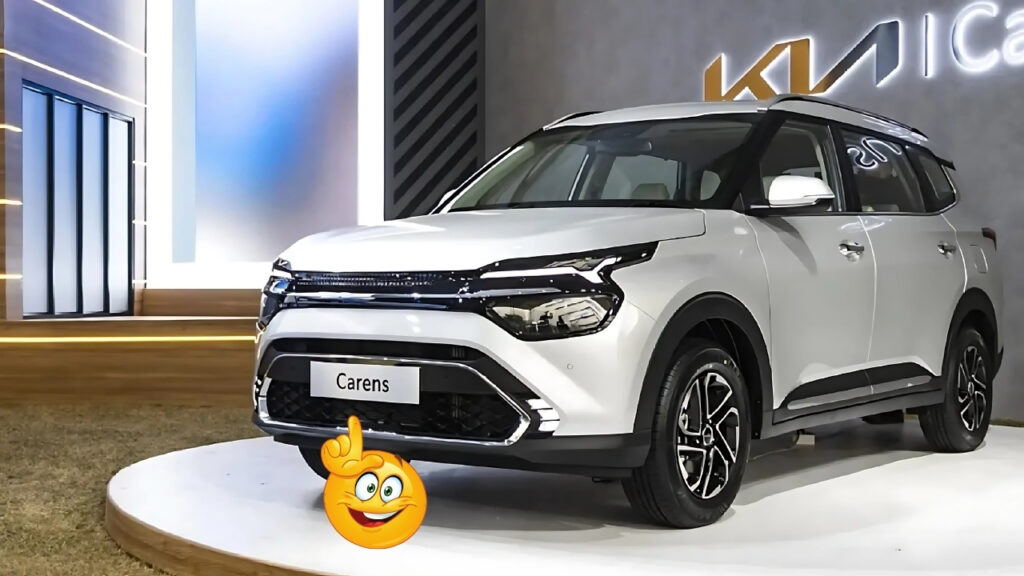Toyota Camry : The unmistakable whisper of a hybrid powertrain announces the arrival of Toyota’s refreshed Camry long before its sleek silhouette becomes visible.
In an automotive landscape increasingly dominated by crossovers and SUVs, Toyota has doubled down on the premium sedan segment with a comprehensively updated Camry that combines executive comfort with technological sophistication and environmental consciousness.
Having spent considerable time behind the wheel of this latest iteration during its media preview event last week, I’ve developed a nuanced understanding of how Toyota has reimagined this storied nameplate for increasingly discerning buyers who still prefer the driving dynamics and understated elegance of a proper sedan.
Table of Contents
Toyota Camry A Design Evolution That Commands Attention

The Camry has undergone a striking visual transformation that elevates it far beyond its sometimes conservative image.
The front fascia features a dramatically sculpted bumper flanked by sharp LED headlamps that create a genuinely imposing presence.
The enlarged grille—finished in a distinctive black mesh pattern on higher trim levels—strikes a balance between aggression and sophistication that previous generations sometimes struggled to achieve.
“We wanted to create something with genuine road presence that still maintains the elegance expected of a premium sedan,” explains Masato Katsumata, Toyota’s exterior design lead for the project.
“The stance is more planted, the proportions more dynamic, but the overall impression remains sophisticated rather than overtly sporty.”
This approach becomes evident when viewing the sedan in profile, where a gently sloping roofline creates a fastback-inspired silhouette without compromising interior headroom.
Character lines along the body sides add visual interest while managing to avoid the over-styling that afflicts some competitors.
The rear completes this cohesive design with horizontally oriented LED taillamps connected by a slim chrome strip, adding visual width and a contemporary flourish.
Available in seven exterior colors, including the striking Celestial Silver Metallic and emotional Red Mica, the Camry allows buyers to emphasize either its executive character or its more dynamic personality based on color selection.
The higher-spec variants feature 18-inch multi-spoke alloy wheels with a machine-finish treatment that adds a premium touch while maintaining visual restraint.
Toyota Camry Cabin Experience: Where Luxury Meets Technology
Stepping inside the new Camry reveals Toyota’s most impressive interior execution to date for this model line.
Materials quality has taken a substantial leap forward, with soft-touch surfaces covering nearly every point of contact.
The dashboard layout follows a horizontal theme, creating a sense of width while intelligently organizing controls based on frequency of use.
The centerpiece of the cabin is an expansive 10.1-inch floating touchscreen infotainment system that supports wireless Apple CarPlay and Android Auto integration.
Unlike some competitors, Toyota has wisely retained physical controls for climate and essential audio functions, allowing for intuitive operation without diverting attention from the road.
“We conducted extensive user experience testing to determine the right balance between digital and analog controls,” notes interior designer Takeshi Miyagawa.
“The conclusion was clear—some functions benefit from digitization, while others remain more intuitive and less distracting when operated through physical controls.”
This thoughtful approach extends to the seating, where the front chairs offer 8-way power adjustment with both heating and ventilation functions.
The driver’s seat adds memory settings and adjustable lumbar support, creating a genuinely comfortable environment for extended journeys.
Rear passengers haven’t been overlooked, with generous legroom and a center armrest that includes cup holders and USB charging ports.
Particularly impressive is the attention to acoustic comfort. Enhanced sound insulation in the floor, doors, and firewall combines with acoustic glass in the windshield and front windows to create a remarkably hushed environment.
During testing on expressways at 100 km/h, the cabin remained library-quiet, with only the faintest whisper of wind noise around the A-pillars.
Toyota Camry Technological Sophistication That Enhances the Experience
Beyond the obvious infotainment upgrades, the new Camry introduces technological features that meaningfully enhance the ownership experience rather than simply adding complexity.
The digital instrument cluster—a 7-inch multi-information display flanked by analog gauges in lower trims and a fully digital 12.3-inch panel in higher variants—provides customizable information layouts that prioritize different data based on driving modes and personal preferences.
The available JBL Premium Sound System deserves specific mention, featuring 9 speakers strategically positioned throughout the cabin and a dedicated amplifier.
During testing with various musical genres, the system delivered impressive clarity and separation, with minimal distortion even at higher volumes.
Bass response remains controlled rather than overwhelming—appropriate for the sedan’s sophisticated character.
“We benchmarked sound systems from vehicles costing significantly more,” explains audio engineer Hiroshi Tanaka.
“The goal wasn’t simply loudness but rather accuracy and balance across the frequency spectrum.
The cabin’s excellent noise isolation creates an ideal acoustic environment for appreciating musical nuances.”
Safety technology has similarly evolved beyond basic functionality to create systems that work with remarkable refinement.
The Toyota Safety Sense 2.5+ package includes Pre-Collision System with Pedestrian Detection, Dynamic Radar Cruise Control, Lane Departure Alert with Steering Assist, and Automatic High Beams.
During testing, these systems intervened with unusual subtlety when needed, avoiding the jarring corrections sometimes experienced in competitor vehicles.
Toyota Camry Hybrid Powertrain: Efficiency Without Compromise
The heart of the Camry experience remains its sophisticated hybrid powertrain, combining a 2.5-liter four-cylinder Atkinson cycle engine with an electric motor and continuously variable transmission.
This system produces a combined 208 horsepower while delivering remarkable efficiency—approximately 19-20 km/l in mixed driving conditions during our testing.
Unlike earlier hybrid implementations that sometimes felt compromised, the current system seamlessly blends electric and gasoline propulsion.
From standstill, the electric motor provides immediate torque, creating impressive initial acceleration.
The transition to gasoline power occurs almost imperceptibly, with only the subtle change in soundtrack indicating the switch.
Equally impressive is the regenerative braking system, which has been calibrated to feel natural and progressive rather than abrupt.
During gradual deceleration, energy recovery occurs without the artificial pedal feel that plagues some hybrid and electric vehicles. Only during more aggressive stopping do you notice the transition between regenerative and friction braking.
Three selectable drive modes—Eco, Normal, and Sport—subtly alter throttle response, steering weight, and transmission behavior to suit different driving preferences.
Even in Sport mode, the Camry maintains its fundamentally refined character, though throttle response sharpens noticeably and the gasoline engine remains more engaged to improve responsiveness.
Toyota Camry Driving Dynamics: Comfort with Capability
Toyota’s TNGA platform architecture has transformed the driving dynamics of the Camry, creating a sedan that delivers both impressive ride quality and unexpectedly capable handling.
The front strut and rear multi-link suspension have been tuned to prioritize initial compliance while maintaining body control during more spirited driving.
During testing on varied road surfaces, the suspension demonstrated remarkable versatility. Urban imperfections—including notorious potholed sections—were absorbed with minimal cabin disruption, while higher-speed stability on highway sections remained exemplary even in crosswind conditions.
Steering response strikes an appropriate balance for the sedan’s character—light enough for easy maneuverability at parking speeds but weighting up progressively as velocity increases.
While not sports-sedan sharp, it delivers sufficient feedback to place the car precisely through corners while filtering out unwanted vibrations.
“We wanted to create a broader dynamic envelope than previous generations,” explains chassis engineer Takayuki Yoshida.
“The goal was a sedan that remains serene during daily commuting but has capability in reserve when the driver wants to explore more challenging roads.”
This approach manifests in a car that never feels out of its depth, regardless of driving context.
From negotiating congested urban centers to covering long distances on expressways to the occasional twisting back road, the Camry maintains composure while delivering comfort appropriate to its premium positioning.
Toyota Camry The Ownership Proposition: Beyond the Purchase Price
While the Camry’s base price of approximately ₹45 lakh positions it firmly in the premium segment, the comprehensive ownership experience extends beyond the initial purchase.
Toyota’s legendary reliability remains a core attribute, with engineering decisions prioritizing long-term durability over fashionable complexity.
Service intervals occur every 10,000 kilometers, with maintenance costs remaining predictable and reasonable given the vehicle’s positioning.
The hybrid components receive an extended 8-year/160,000 kilometer warranty, addressing potential concerns about battery longevity and replacement costs.
Resale value represents another significant advantage, with Toyota sedans historically maintaining stronger residual values than many competitors.
This depreciation advantage, combined with the excellent fuel efficiency of the hybrid system, creates a compelling total cost of ownership proposition despite the premium initial purchase price.
Toyota Camry Conclusion: Refined Relevance in a Changing Market
In an automotive landscape increasingly dominated by high-riding crossovers, the Camry makes a persuasive case for the continuing relevance of the premium sedan.
It delivers a driving experience distinctly different from taller vehicles—more connected to the road, more dynamically capable, and often more comfortable over varied surfaces.
The latest iteration builds on these inherent sedan advantages while addressing previous shortcomings through enhanced design presence, technological sophistication, and premium interior execution.
The result is a thoroughly modern interpretation of the luxury sedan that remains true to the values that built the Camry’s reputation while evolving to meet contemporary expectations.
For buyers seeking understated elegance, environmental consciousness, and genuine comfort without the fashion-driven move to crossovers, the new Camry offers a compelling alternative that requires remarkably few compromises.
In maintaining its commitment to the sedan form factor while substantially elevating the execution, Toyota has created perhaps the most complete and convincing Camry in the model’s storied history.





